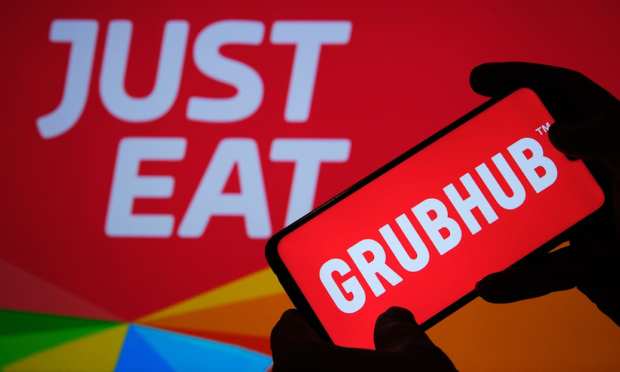5 Risks Highlighted In Just Eat Takeaway.com’s Grubhub Acquisition Prospectus

As Netherlands-based food delivery giant Just Eat Takeaway.com gets closer to finalizing its acquisition of Chicago-based delivery service Grubhub, the former published its prospectus outlining the details of the deal and the associated risks. The prospectus has already been approved by the European Union and United Kingdom authorities and has been filed with the United States Securities and Exchange Commission (SEC).
The acquisition seems to be a fairly intuitive move — the restaurant delivery space is overcrowded with brands competing for the narrow profit margins of each order, so reducing the number of players makes sense, especially with so many major delivery services looking to make up their losses in scale. Still, the restaurant industry is uncertain at the best of times — and with consumers’ preferences changing month-to-month in response to the fluctuations of the pandemic, no one can be sure what the future holds. Below are five of the key risks identified in the prospectus.
Risk #1: Management changes could hurt the company.
“There can be no assurance that executive officers and other key senior management personnel and employees can be retained … to the same extent that the Grubhub Group has previously been able to attract and retain its employees, which could have an adverse effect on the results of operations, business and financial position of the Grubhub Group and, following Completion, the Enlarged Group,” reads the filing.
Specifically, the prospectus indicates that Just Eat Takeaway.com “will be unable to provide” Grubhub’s CEO Matt Maloney “with a remuneration package generally consistent with his remuneration as chief executive officer of Grubhub, which may impact the ability of Just Eat Takeaway.com to retain Mr. Maloney.”
The prospectus also states that “other employees of the Grubhub Group may believe there is uncertainty about their roles,” which could lead to more Grubhub employees leaving the company.
Risk #2: The deal could compromise restaurant relationships.
“The business relationships of [each company] may be subject to disruption due to uncertainty associated with the transaction, which could have an adverse effect on the results of operations, business and financial position of [these companies],” states the prospectus.
It goes on to say that “restaurants and suppliers may attempt to negotiate changes in existing business relationships or consider entering into business relationships with third parties,” and that, as the terms of these relationships change in response to the merger, “counterparties may have the ability to exercise certain rights (including termination rights).”
Risk #3: The delivery services’ brands could be at risk.
In addition to possibly changing the delivery services’ reputations with their restaurant customers, changes as a result of the acquisition could also affect consumers’ view of these companies. The prospectus states, “Brands will continue to be a key part of [our] value proposition relative to actual and potential competitors, and therefore, any failure to maintain brand appeal is a potential business threat.”
It adds that the delivery industry is “impacted by dynamic social change and public expectation, such as food safety, allergens and workers’ rights,” and that “the effect of negative publicity could be exacerbated to the extent dissatisfaction with [our delivery services] is disseminated via social media due.”
In addition to these concerns, the prospectus also states that the brands’ ability to retain their customers “will depend on the quality and user-friendliness of their websites and mobile applications and the quality of their back-end technology infrastructure,” adding that these companies “will need to continuously enhance and improve the functionality and features of their websites and mobile applications to maintain a convenient, efficient and reliable user experience for consumers, restaurants and drivers.”
Risk #4: The acquisition could suffer from the fallout of the recent Just Eat deal.
Just Eat Takeaway.com was formed from the merger of U.K. delivery service Just Eat and Netherlands-based Takeaway.com, which was finalized in the summer of 2019. The prospectus reveals that there are still loose ends from this deal that could affect business in the future.
“Just Eat Takeaway.com recently completed the Just Eat acquisition, which was a transformative transaction and for which the process of integrating the two businesses is ongoing,” the filing reads. “Just Eat Takeaway.com may encounter difficulties integrating Just Eat into its existing business.”
The prospectus goes on to say that these challenges “may exacerbate the risks Just Eat Takeaway.com faces in integrating Grubhub or any future business it acquires, and could cause an interruption of, or a loss of, momentum in the Just Eat Takeaway.com Group’s activities, and could have a material adverse effect on its business, financial condition and results of operations.”
Risk #5: The delivery economics may not work out.
Grubhub continues to see major losses, with the most recent quarter netting $75.5 million in losses. Some have cast doubt on whether the third-party delivery model can work, given the economic constraints from restaurants, consumers, technology partners and local legislatures alike.
“The Just Eat Takeaway.com Group has a history of net losses, and the Just Eat Takeaway.com Group, the Grubhub Group and, following Completion, the Enlarged Group could continue to incur substantial net losses in the future, and may not become profitable in the future,” reads the prospectus. “…[These companies’] operating expenses may increase over time, particularly as they make investments to scale and expand their businesses. These investments may not result in increased revenue or higher growth.”
The COVID delivery boom of the past 14 months also poses its own challenges. The prospectus stated that these companies’ recent revenue growth “may not be sustainable, and if their revenue declines or fails to grow at a rate faster than increases in their operating expenses, the Just Eat Takeaway.com Group and the Grubhub Group may not achieve or maintain profitability in future periods.”